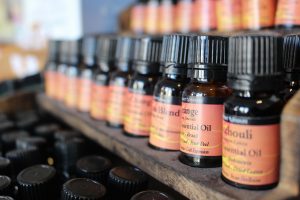Organic vs Non-Organic Essential Oils
The Difference Between Organic and Non-Organic Essential Oils

There likely wouldn’t be a debate on the difference between organic and non-organic essential oils (EO) if there weren’t a significant price gap and not so noticeable difference in quality. It rightly makes people wonder: what makes these oils, produced in the same manner, so different? As with every debate, there are pros and cons to each standpoint. But to truly understand both, it is important to know where “organic” enters the process of making essential oils and why.
Organic: A certificate that sells with the uncontrolled use of pesticides growing at an alarming rate, justified health concerns have arisen. According to the World Health Organization, pesticides negatively affect the human immune system and may cause detrimental health effects, including cancer.
The standards that make the basis of organic agriculture satisfy the need for control and limitation of harmful chemicals. At the same time, they pave the road for the production of healthier food and help us reach holistic health goals. To ensure that the standards are applied correctly, certification companies made their way onto the stage. However, high certification costs, among other expenses, raised the price of a final product.
While a product titled organic may claim some advantages over non-organic, quality and pesticide content are often not among them. This is particularly true in the case of specific essential oils due to their production process.
The making of (non-)organic essential oils makes a difference both organic and non-organic essential oils are typically made either via distillation or cold pressing. During distillation, steam extracts small molecules of essential oil from the plant. At the same time, steam destroys the temperature-sensitive molecules of pesticides. Even if harmful chemicals survive, these molecules are too big and heavy to be carried by steam into the distillate with essential oil.
Should any molecules of a water-soluble chemical squeeze through, it stays down in the water. A pure essential oil that’s lighter than water simply gets scooped from its surface. If pesticide molecules do find their way into the final product by any chance, they are present in harmless, trace quantities.
The issue with non-organic essential oils starts with cold pressing. Physical extraction of essential oil from citruses is the best example. If pesticides were applied, they would easily get in touch and mix with the essential oil, polluting the final product. What makes things even worse, pesticides used for spraying on citruses are often oil-soluble.
It is necessary to add that the plants whose essential oil is the least contaminated by pesticides are those which act as natural pesticides themselves. These are the same plants that go through distillation. Not only do they naturally repel pests, but their oil is also purified through the extraction process.
This makes the extraction process and the plant species essential (pun intended) in determining the difference in the quality of organic and non-organic aromatic oils. Organically produced citrus oils are likely to have a lower content of pesticides thanks to the standards applied.
One thing should be clear, though – the fact that something is produced organically doesn’t mean it is pesticide-free. Organic agriculture uses either organic pesticides or recommended smaller amounts of approved conventional pesticides.
How to determine the quality of essential oils: Specific chemical methods and tests can precisely and accurately determine the quality of oil and the content of harmful chemicals within. But small-batch producers who can’t cover organic certification expenses can neither bear the costs of numerous and frequent analyses. What is more, they can’t compete with big essential oil companies, even if their oil is equally safe and beneficial. Moreover, to keep their beauty products safe during transportation, they need to ensure that the whole essential oil supply chain is flawless. And it costs.
A way to balance the scales is to carefully examine the chosen manufacturer and their farming method before buying their product. Small but reliable essential oil producers can be highly competitive in the market, even without the certified organic stamp. This is entirely due to their transparent supply chain – a process of cultivation, extraction, and bottling of essential oils.
The case is clear with organically produced essential oils. The strict process of certification, resulting in a stamp, guarantees that the essential oil doesn’t contain harmful residues. However, it doesn’t necessarily imply that the quality is up to par at the same time. The quality of non-organic essential oil may sometimes be higher than the one produced organically.
It’s a thin line between organic and non-organic essential oils… Is non-organic necessarily bad? No – especially when it comes to essential oils. Most non-organic essential oils have the potential to satisfy all quality standards of organic EO except one thing: the certification process itself.
This is because some of the plants used for the production of some of the best essential oils are often not grown but harvested from the wild. These plants, such as thyme or eucalyptus, are available in nature away from farms, fertilizers, and pesticides.
There is nothing more organic than nature itself. However, there’s no one to cover the certification expenses and document the cultivation methods of freely grown plants.
Which essential oil should you buy?
The production of organic essential oils should be supported. But small producers deserve support, too. It may seem that the debate aims to determine the difference between organic and non-organic essential oils so that a winner can be declared. However, the whole point is in making farming responsible. The standards of organic agriculture are not secret. They can be applied to ensure the creation of the best possible product even if it’s not certified.
In the end, it is up to consumers to choose. Regardless of what we are shopping for, we are expected to make an informed decision. The price tag on an essential oil bottle plays an important role, but it shouldn’t be the only deciding factor. Things that we all should take into account are not marketing praises. It is the transparency of the specific plant cultivation and oil extraction process that matter.

No comments yet.